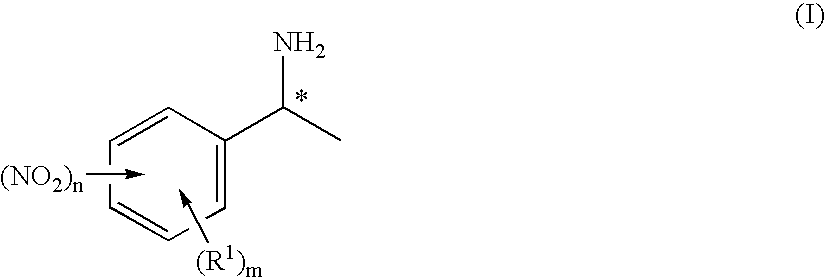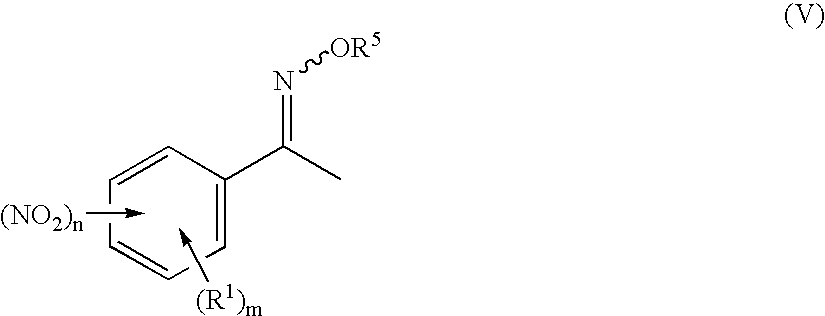Enantiomerically enriched 1-phenylethylamines
- Summary
- Abstract
- Description
- Claims
- Application Information
AI Technical Summary
Benefits of technology
Problems solved by technology
Method used
Image
Examples
example 1
Preparation of 3-nitro-N-methoxyiminoacetophenone
[0091] 240.0 g (1.453 mol) of 3-nitroacetophenone are suspended at room temperature in 1200 ml of ethanol. A solution of 132.0 g of O-methylhydroxylamine hydrochloride in 120 ml of water is added dropwise in 45 min to the suspension. The reaction mixture is heated to boiling and stirred at this temperature for 4 h. The suspension is subsequently hot-filtered. The filtrate is cooled to room temperature over a period of 12 h. The colourless solid which precipitates out in this time is filtered off with suction using a frit and washed three times with 100 ml of ethanol each time. The product is dried at 50° C. and a pressure of 100 mbar over a period of 2 h. 235.3 g (83.2% of theory) of a pale yellow solid are obtained.
example 2
Preparation of 1-(3-nitrophenyl)ethylamine
a) Activation with Acetic Acid
[0092] 100 g of dry tetrahydrofuran are initially charged under an argon atmosphere. 3.78 g (0.10 mol) of sodium borohydride are added to the solvent. The suspension is stirred at room temperature for 15 min. Subsequently, 6.0 g (0.10 mol) of acetic acid are added dropwise at a temperature of 20° C., in the course of which vigorous gas evolution sets in. Over a period of 20 min, a solution of 4.86 g (0.025 mol) of 3-nitro-N-methoxyiminoacetophenone in 40 ml of tetrahydrofuran is then added. The reaction mixture is stirred at room temperature for 2 h and subsequently heated to reflux for 2 h. Afterwards, the mixture is cooled to 110° C. and 60 ml of water are added dropwise with stirring at this temperature. The solvent is removed on a rotary evaporator. The residue is taken up in 150 ml of water and adjusted to pH 1 using 10 ml of conc. hydrochloric acid. The aqueous solution is washed with 50 ml of dichlorom...
example 3
Preparation of (S)-1-(3-nitrophenyl)ethylamine
a) Crystallization with L-(+)-tartaric Acid
[0095] 0.75 g (5.0 mmol) of L-(+)-tartaric acid is dissolved in 64 ml of methanol and the solution is heated to reflux. A solution of 1.0 g (6.0 mmol) of 1-(3-nitrophenyl)ethylamine from Example 2 in 7.1 ml of methanol is metered in over a period of 5 min and the mixture is subsequently stirred under reflux for 15 min.
[0096] The solution is cooled to 50° C. over a period of 40 min and subsequently to 35° C. over a period of 1.5 h. The solution is then stored at 5° C. for 4 days. The solid which precipitates out in this time is filtered off. 0.5 g of a beige solid is obtained. This is suspended in 10 ml of water and adjusted to pH 10 using 0.9 ml of 10% sodium hydroxide solution. The solution is extracted twice with 30 ml each time of dichloromethane. The solvent of the combined organic phases is removed on a rotary evaporator. 0.3 g (30% of theory) of (S)-1-(3-nitrophenyl)ethylamine is obtai...
PUM
 Login to View More
Login to View More Abstract
Description
Claims
Application Information
 Login to View More
Login to View More - R&D
- Intellectual Property
- Life Sciences
- Materials
- Tech Scout
- Unparalleled Data Quality
- Higher Quality Content
- 60% Fewer Hallucinations
Browse by: Latest US Patents, China's latest patents, Technical Efficacy Thesaurus, Application Domain, Technology Topic, Popular Technical Reports.
© 2025 PatSnap. All rights reserved.Legal|Privacy policy|Modern Slavery Act Transparency Statement|Sitemap|About US| Contact US: help@patsnap.com



